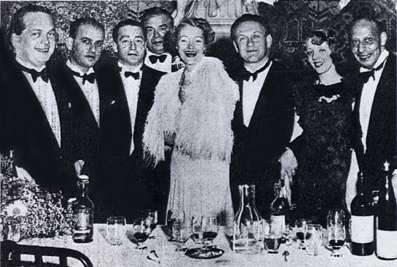Walter Herbert (conductor)
Walter Herbert (né Seligmann, February 18, 1898 – September 14, 1975)[1] was an American conductor and impresario of German birth, and also a world champion at contract bridge.
Operatic career
He was born Walter Seligmann in Frankfurt, and studied composition under Arnold Schönberg in Vienna. He gained experience as conductor in Germany and Switzerland, and was later appointed chief conductor at the Vienna Volksoper (1931–38). His operatic debut was with Carmen, at the Stadttheater Bern in 1925. Shortly before the 1938 Anschluss of Germany and Austria, Herbert visited Japan to introduce modern western classical music to that country. From there he migrated to the United States, and became an American citizen in 1944.
Herbert was director of Opera in English (San Francisco, 1940–43); and in 1943 was appointed the first general director of the New Orleans Opera Association, which post he held until 1954. He founded the Houston Grand Opera in 1955, where he remained as both general director and conductor until 1972; and was music director of Opera/South (founded by Sister M. Elise Sisson, SBS) in Jackson, Mississippi. He founded the San Diego Opera in 1965, and was its general director and conductor from 1969 until his death.
Herbert worked with most of the great singers of his day, and gave many of them their start in the opera world. In April 1948, during Herbert's regime in New Orleans, the young Mario Lanza made one of his very few operatic stage appearances, as Lieutenant Pinkerton in Madama Butterfly; under Herbert's baton and Armando Agnini's stage direction. (It was announced in May 1948 that Lanza had accepted the role of Alfredo Germont, in the New Orleans Opera's La traviata; but Hollywood apparently interfered with those plans.)
World-class Bridge player

At the bridge table in the 1930s, Herbert was one member of the Austria national team led by Paul Stern. The team won four of the first six European teams championships, with Herbert playing in 1933 and 1937.[2][3] The 1937 field included two teams from the United States and doubled as the first world championship tournament.[4]
The Herbert Negative is a bridge convention advocated by Walter Herbert, based on the idea that a negative response in a variety of situations can be made by making the cheapest possible suit response, e.g. as a response to a forcing two-bid.[5]
Commercial Discography
- Verdi: Un ballo in maschera (S.Morris, Schuh, Larrimore, Björling, Rothmüller, Treigle; 1950) [live] VAI
- Verdi: Rigoletto (Güden, Conley, Warren, Wilderman, Treigle; 1952) [live] VAI
- Verdi: La forza del destino (Milanov, Turner, del Monaco, Warren, Treigle; 1953) [live] VAI
- Ponchielli: La Gioconda: excerpts (Milanov, Turner, Madeira, Turrini, Bardelli, Moscona; 1953) [live] VAI
References
- ↑ "Walter Herbert". Social Security Death Index. Retrieved 2009-07-26.
Walter Herbert 18 Feb 1898 Sep 1975 92101 (San Diego, San Diego, CA) (none specified) 556-16-2967 California.
horizontal tab character in|quote=at position 36 (help) - ↑ European Team Championships To Date list. European Bridge League. Confirmed 2011-09-08. Select a champion team name to see its personnel.
- ↑ Manley, Brent, Editor; Horton, Mark, Co-Editor; Greenberg-Yarbro, Tracey, Co-Editor; Rigal, Barry, Co-Editor (2011). The Official Encyclopedia of Bridge - Biographies and Results (compact disk) (7th ed.). Horn Lake, MS: American Contract Bridge League. p. 213. ISBN 978-0-939460-99-1.
- ↑ There were two teams from the US in the field of 19 otherwise national teams.
Alan Truscott (June 21, 1987). "BRIDGE: A Viennese Victory". The New York Times. Retrieved 2008-08-14. - ↑ Manley, Brent, Editor; Horton, Mark, Co-Editor; Greenberg-Yarbro, Tracey, Co-Editor; Rigal, Barry, Co-Editor (2011). The Official Encyclopedia of Bridge (7th ed.). Horn Lake, MS: American Contract Bridge League. p. 290. ISBN 978-0-939460-99-1.
Further reading
- San Diego Opera 30th Anniversary Commemorative Book, San Diego Opera, 1995
- "SD Opera's founding director introduced contemporary works," by John Patrick Ford, San Diego Source, August 6, 2015.
External links
- Walter Herbert conducting an excerpt from Faust on YouTube, with Frances Yeend, Richard Cassilly, and Norman Treigle (1957, Houston concert)
- "International record for Walter Herbert". World Bridge Federation.
